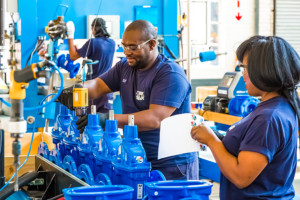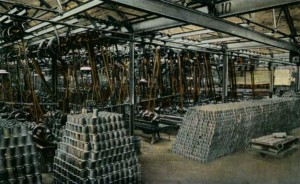 An assembly line is a manufacturing process in which a product is built in a step-by-step sequence. One of many decisions when installing an assembly line has to do with its pacing. When should you use a pulsed line? When a continuously moving line? And when is an unstructured timing best? This post will look at the pros and cons of these options.
An assembly line is a manufacturing process in which a product is built in a step-by-step sequence. One of many decisions when installing an assembly line has to do with its pacing. When should you use a pulsed line? When a continuously moving line? And when is an unstructured timing best? This post will look at the pros and cons of these options.
Introduction
There are three fundamentally different ways when you can move a part along an assembly line to the next station. Let me give you a brief overview before going into the finer details which one to use when.
The untimed line moves products between stations independently of the status of the other station. Whenever a station is ready, it takes the next part (if the next part is available). Whenever it is done, it moves the completed part to an inventory (if space is available). Then the cycle repeats. See my first post on the pacing of flow lines for more details.

The pulsed line moves all parts at the same time. Again, see my first post on the pacing of flow lines for more details.

The continuously moving assembly line moves… well… continuously. The processes have to move along with the parts. See my second post on the pacing of flow lines for more details.

Now let’s compare these lines according to different criteria.
Balancing the Line
The unstructured line is easiest to balance. Any fluctuations between the stations are buffered with inventory. Of course, a long-term slower station (the bottleneck) will still slow down everybody else. But that is true for all lines. Fluctuations are usually much more of a concern in pulsed or continuously moving lines, as all parts move at the same speed or at the same time, and a delay at one station means a delay for the entire line. On the plus side, this puts a lot more pressure on improving the line.
Parts Movement
 In any line, you have to move the parts along. Here, the unstructured line is very flexible. The parts can be moved manually or automatically, and the line is almost independent of the way to move the parts. The decision on the way to move the material depends more on the size and weight of the part as well as the available funds.
In any line, you have to move the parts along. Here, the unstructured line is very flexible. The parts can be moved manually or automatically, and the line is almost independent of the way to move the parts. The decision on the way to move the material depends more on the size and weight of the part as well as the available funds.
For the pulsed line you can also move the parts manually or automatically. However, getting the timing right is tricky if the parts are moved manually, and an automatic system would be better.
The continuously moving assembly line, however, must be moving automatically. The parts are moving all the time, and the workers are working on the parts while they are moving, and hence have no time to also move them simultaneously while working. Even if they could, it would be very difficult for them to get the speed right. Hence, here an automatic system is needed.
Machines
 Both the unstructured line and the pulsed line can easily have machines as part of the assembly line. The part moves into the machine, gets processed, and then moves on.
Both the unstructured line and the pulsed line can easily have machines as part of the assembly line. The part moves into the machine, gets processed, and then moves on.
For a continuously moving line, this is also possible but a bit trickier. As the part is continuously moving, the process has to move along. For workers this is usually no problem. However, a machine needs to move along with the part during the process, and then move back for the next part. This is all doable, but with a bit more effort.
Staffing

Untimed lines are easiest to work with partial staffing. You could put a worker (or team) at every station, or have less workers than stations (also known as chaku-chaku line). Methods like the baton touch, rabbit chase, or one-up-one-down work well if the processes are not linked to each other timewise.
Both pulsed lines and continuously moving lines are more difficult to run with partial staffing. It is possible but requires more effort to set up.
Setting the Speed
At an unstructured line, the workers are done whenever they are done. There may be some standard with a recommended time, but these are usually ignored. On a pulsed or continuously moving line, there is a set speed at which the line runs. Delays and problems are highly visible (see more below).
Management
The unstructured line is easiest to set up, but it takes most effort to organize. Having a lot size one is more difficult, and getting the right material to the right process is trickier. Due to the fluctuations and the buffer inventory between the stations, it is also harder to predict the lead time. All of that makes the management of such an unstructured line trickier.
A pulsed or a continuously moving assembly line is much easier to manage. The lead time is easier to predict, and you know better when your product will be ready.
Inventory
 The unstructured line has probably the most inventory. You need the inventory to balance fluctuations between the stations. It is possible to also have a leaner line with less inventory, but in my experience the inventory is usually more on such lines.
The unstructured line has probably the most inventory. You need the inventory to balance fluctuations between the stations. It is possible to also have a leaner line with less inventory, but in my experience the inventory is usually more on such lines.
Both the pulsed and the continuously moving line do not need any inventory between the stations. Hence, the inventory can be as low as the number of stations. For longer lines there may be some inventory buffers between segments (see, e.g., my article on the Toyota Motomachi plant).
Visual Management and Improvement
 In my view, one of the biggest drawbacks of the unstructured line is the lack of visual management. Finding the bottleneck is more difficult. In general, seeing problems is harder, as they are hidden by the excess inventory. Problems are also often less urgent… which means they do not get fixed.
In my view, one of the biggest drawbacks of the unstructured line is the lack of visual management. Finding the bottleneck is more difficult. In general, seeing problems is harder, as they are hidden by the excess inventory. Problems are also often less urgent… which means they do not get fixed.
Pulsed and continuously moving lines have a much easier visual management. Problems are seen earlier and easier, and… they hurt! Hence, there is a much higher drive to fix the problems. It is like exercising. Sitting on the couch is easier, but exercise is healthier. A pulsed or continuously moving line is—sort of—forcing you to exercise. Hence, pulsed and continuously moving lines are often more efficient and productive than an unstructured line simply because problems are more visible and painful, and therefore more frequently fixed.
Summary
All types of pacing for assembly lines are used in industry, as all have their applications. High-end lines like, for example, automotive assembly lines are usually a continuously moving line. If it is airplanes or machine tools, however (see Trumpf Syncro for a good example), a pulsed line is often used for mass production.
If there is more machinery involved, as for example the welding shop in automotive, a pulsed line is often used. It is just easier to have the product stop for the process rather than have the welding robots move along with it.
Unstructured lines are in my experience often smaller lines, as for example sub-assemblies. My gut feeling is that any line that has management focus and is optimized for performance is usually pulsed or continuously moving. Any line that is not in the spotlight is often unstructured. In any case, now go out, pace you line properly, and Organize your Industry!

Hello Chris,
great post, as usual.
I have studied in detail your two previous posts on Trumpf Synchro. There you say that Trumpf implemented a one piece flow production system, with a comparably low inventory reach (for machine tool builders) of one to two days.
I have two questions:
(1) I don’t seem to find any reference to a pulsed line in your Trumpf posts, have I overlooked it, or, is it implied elsewhere in the text?
(2) We assume a pulsed line is preferable in the case of Trumpf. Is this because of a much higher inventory reach (compared to Toyota) or because of different types of production processes? To mind comes more product variants in case of Trumpf.
Thanks a lot in advance for your thoughts on this.
Regarding my (1) question, I found this in your post of April 11, 2017: “German machine tool maker Trumpf uses a pulsed line with a cycle time of around 8 hours for its machine tool assembly”.
It would be interesting to know when a pulsed line is preferable over a continuously line (and vice versa).
Hello Leo, for very long cycle times (8 hours), I feel it would be easier to just move them all at the same time once. Otherwise you need a lot of equipment that has to adapt for moving for an extremely slow moving process (6 meter in 8 hours?). There may be other reasons, I have to think about this more. Good Question! I have a bit more in my post How to Pace Your Assembly Line.